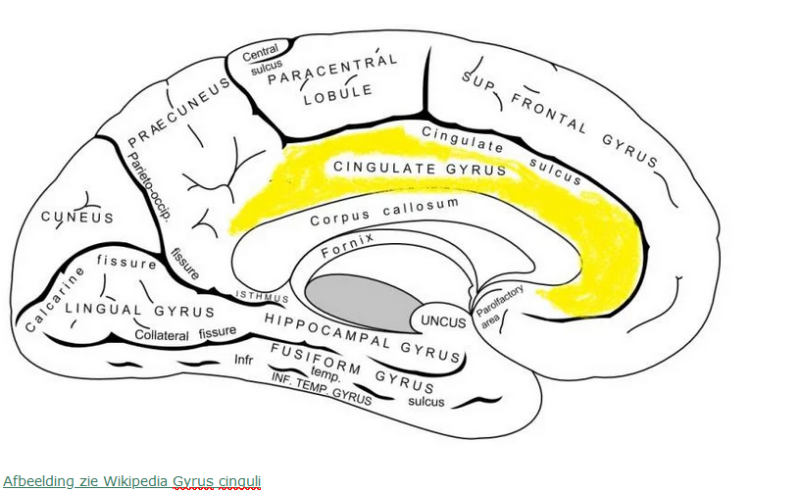Cingulate Gyrus
Foreword: The brain works together as one whole. Brain functions are spread throughout the brain areas and arise from the exchange between the areas. However, complaints can be identified per brain area.
What does the name mean?
Cingel means belt. The anatomists saw this brain area running around the brainbar like a belt. Gyrus means convolution.
Where in the brain?
The cingulate gyrus / cingulatus gyrus is a girdle coil of the cerebrum (yellow in the image below) and as mentioned, this runs
brain area like a belt around the brainbar (corpus callosum). The girdle coil is located deep in the groove between the two hemispheres of the brain.

The belt winding consists of two parts:
1. the anterior cingulate gyrus or anterior girdle coil
2. the posterior cingulate gyrus or posterior girdle coil.
A bundle of white fibers called the cingulum runs through the cingulate gyrus.
Function
The front part of this area (anterior cingulate cortex / ACC) is characterized by the following functions:
- Spontaneous emotional expressions
- Processing of positive and negative reinforcers (reward and punishment)
- Motivation
- Processing emotional stimuli
- Processing emotional resistance to painful stimuli
- Regulation of blood pressure and heart rate functions
It is therefore predictable that injury in this area affects these functions.
An area in the cerebellum, the para vermis, is also involved in reward and punishment circuits.
The posterior part, the posterior cingulate cortex / PCC is associated with pain recall and episodic memory retrieval.
Part of the limbic system
The cingulate gyrus belongs to the limbic system.
The limbic system is located at the edge below the cerebral lobes.
The entire limbic system is formed by a group of brain structures in the cerebrum that are involved in emotion, emotion regulation,
emotional memory, pleasure and motivation.
Hormones are produced here, among other things, and temperature and appetite are regulated.
Damage to the limbic system can bring the hormonal system out of balance. The ability to perceive hunger or a feeling of satiety
taking is reduced and emotional responses may change.
More information about the cingulate gyrus can be found here.
Resources
Bush, Luu & Posner Bush, G., Luu, P. & Posner, M.I. (2000). Cognitive and emotional influences in anterior cingulate cortex. Trends in Cognitive Sciences, 4: 215-222
Nielsen FA, Balslev D, Hansen LK (2005). "Mining the posterior cingulate: segregation between memory and pain components" (PDF). NeuroImage. 27 (3): 520–532 doi:10.1016/j.neuroimage.2005.04.034. PMID 15946864. S2CID 18509039.
Boxer, A. L., Rankin, K. P., Miller, B. L., Schuff, N., Weiner, M., Gorno-Tempini, M.-L., and
Rosen, H. J. (2003). Cinguloparietal atrophy distinguishes Alzheimer disease from semantic
dementia. Archives of Neurology, 60(7):949–956. PMID: 12873851. DOI: 10.1001/archneur.
60.7.949. ISSN 0003-9942
Vogt, B.A. & Morecraft, R.J. (2009). Cingulate gyrus. In M.D. Binder, N. Hirokawa & U. Windhorst (Red.), Encyclopedia of neuroscience. (pp. 722-725). Berlin-Heidelberg: Springer-Verlag.